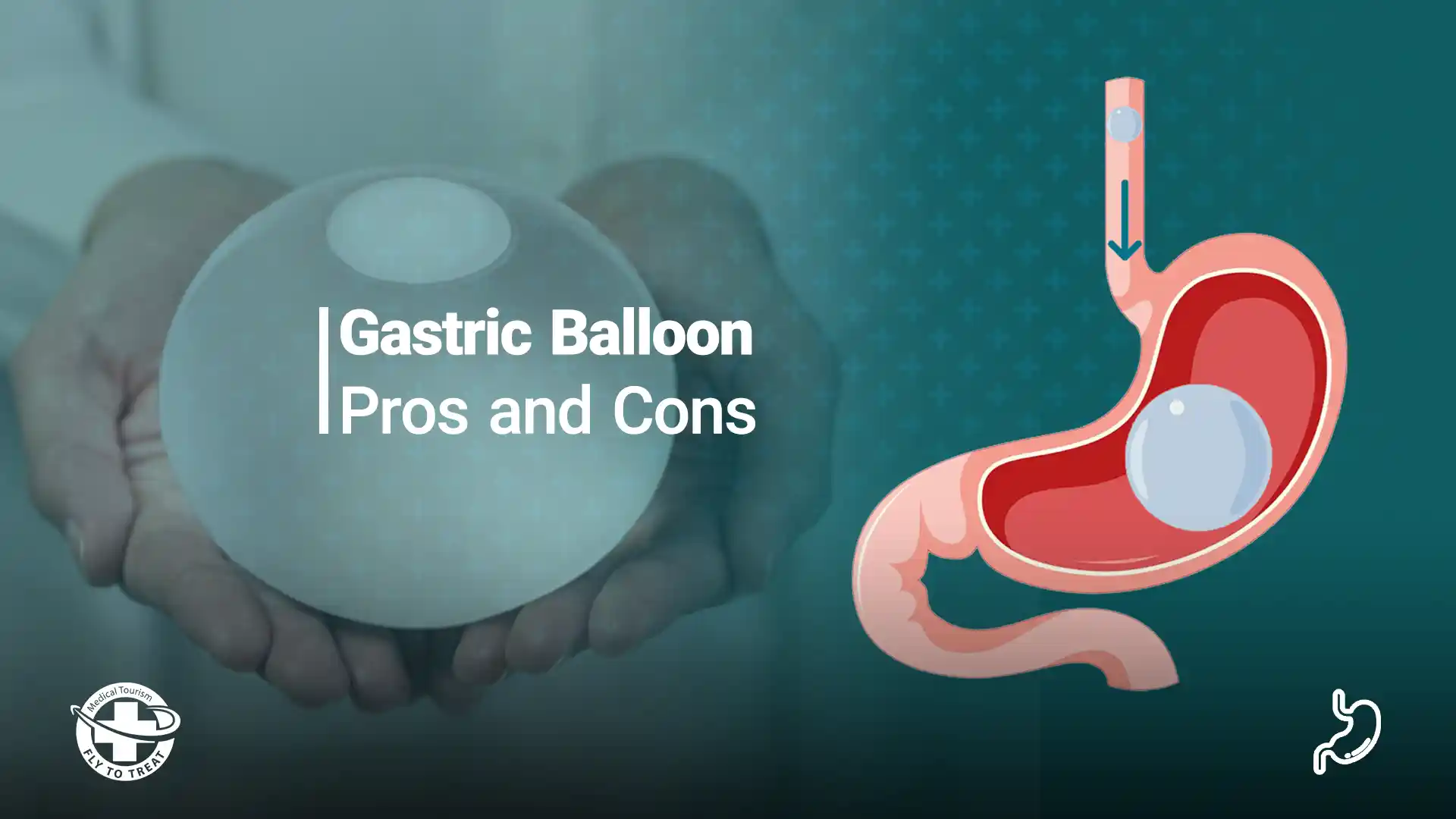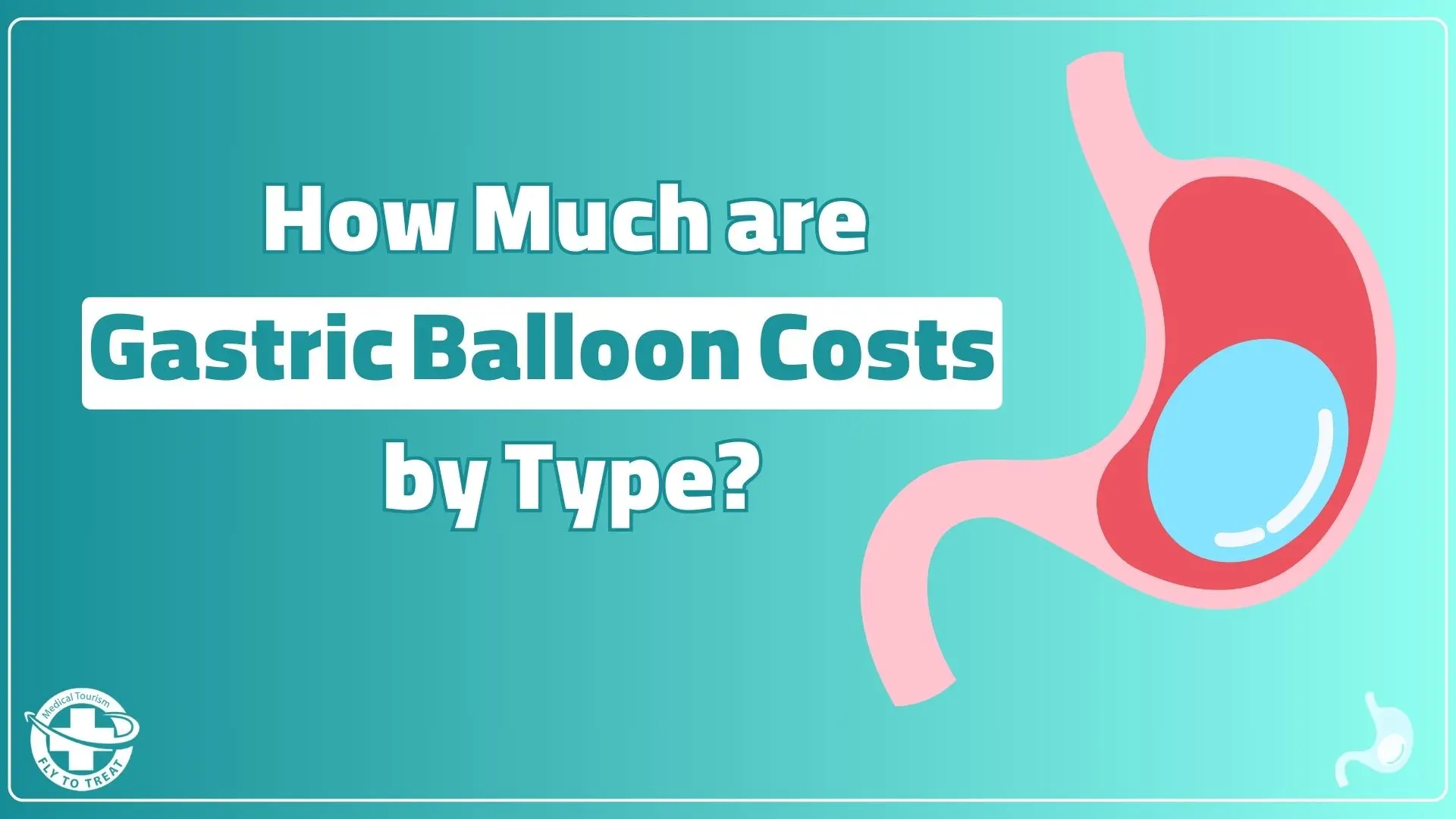
What are Gastric Balloon Pros and Cons?
Gastric balloon side effects and the possible risks of this obesity treatment is essential before beginning the process of losing weight with a balloon inside the stomach.
Gastric balloon is the safest weight loss method with the least chance of complications. In contrast to surgical techniques, it is reversible and does not involve an incision. Thus, there are no scars or scarring, and your stomach or digestive tract is not altered within. This operation does have certain complications, though, just like any other medical procedure.
In this article, we'll cut through the complicated details and provide a clear summary of the positive and negative aspects of the gastric balloon technique. 
Table of Contents
What are the Side Effects of a Gastric Balloon?
A Balloon inside the stomach can have some mild side effects that are common and specialists frequently recommend medicine to avoid or manage them. Though they can occasionally remain longer, symptoms typically only last a week or so.
Some of the side effects of balloon in stomach include:
-
Vomiting & Nausea
One of the gastric balloon side effects is that you may feel nauseated. Around ninety percent of patients experience nausea and vomiting within the first three to seven days following the insertion of the gastric balloon. Your stomach isn't used to it, which is why. Because the balloon cannot be digested like other foods, it causes nausea or vomiting, along with the need to throw it out involuntarily.
Medications will assist you in recovering from this condition. After the first seven days, you must contact your doctor if you continue to suffer discomfort in your stomach or have problems staying hydrated.
- Acid Reflux
Heartburn and acid reflux may be seen later as side effects of stomach balloon. Coffee, alcohol, spicy foods, and fatty foods may worsen the problem. Consuming dairy products and low-fat milk can aid with reflux in such a situation.
-
Stomach Cramps & Discomfort
As your stomach adjusts to the balloon, you may experience discomfort and cramping. Regular drugs can still be used to address this condition. Once your stomach adjusts to the balloon, any temporary cramping will stop.
-
Feeling Bloated
Patients must gradually transition from liquids to pureed foods and avoid drinking fizzy or carbonated drinks, as they may result in bloating and gas.
-
Stomach Ulceration
Stomach ulcers can develop as a serious complication following the insertion of an intragastric balloon, particularly in patients who make unhealthy lifestyle choices, emphasizing the importance of ongoing care and lifestyle management to prevent such life-threatening conditions.
-
Balloon Deflation
Among other intragastric balloon side effects, balloon deflation happens when the silicone balloon bursts or leaks, which could cause major problems. Abdominal pain, fast weight gain, or symptoms of intestinal blockage, such as severe pain and vomiting, are possible symptoms. An immediate medical assessment is necessary if deflation is suspected since surgical intervention may be necessary to remove the balloon and clear any obstructions.
-
Bad Breath
Bad breath or burps that have a bad or unpleasant smell can result from food coating the intragastric balloon. Drinking clear liquids, such as water or herbal tea, will help wash away food particles and relieve discomfort. Sucking on ice cubes can also increase saliva production, which helps with cleaning and lessening offensive smells.
-
Eructation
Patients with a gastric balloon frequently have eructation, also known as burping. A balloon inside the stomach can raise pressure and cause gas to build up, which is why this happens. Patients may have more frequent burping as they become used to the balloon, mainly if they eat too rapidly or drink carbonated beverages. Although excessive burping can be uncomfortable and maybe a sign of problems like bloating or stomach distension, eructation is usually harmless.
-
Gastrointestinal Perforation
Among side effects of stomach balloon, gastrointestinal perforation can happen with gastric balloons when a hole occurs in the gastrointestinal tract, frequently due to misplacement, mechanical stress, or an aggravation of pre-existing ulcers. Signs of shock, fever, vomiting, and excruciating stomach pain are among the symptoms. Since this is a medical emergency, the perforation must be repaired surgically immediately, and antibiotics must be used to stop the infection.
-
Bowel Obstruction
This gastric balloon side effect is rare,it happens in less than one out of every 200 gastric balloon insertions. If the balloon deflates and slides into the lower stomach or colon, it could create obstruction. This could result in serious symptoms like vomiting, increasing bloating, and severe stomach pain. If you experience these symptoms, you should immediately consult a doctor so your stomach balloon can be removed.
-
Reduced Bowel Movements
Patients with gastric balloons frequently worry about decreased bowel motions, which eating habits, changes in gastrointestinal motility, or the balloon itself can cause. Because of the limited area, people may feel more satisfied and consume less fiber and liquids, which could cause congestion. Some patients may also observe a decrease in gastrointestinal motility as their bodies adjust to the balloon. Among the symptoms include bloating, abdominal pain, and irregular bowel motions.
-
Balloon Rupture
This can occur when a hole or tear forms in the silicone balloon, causing its contents to leak into the stomach due to overinflation, mechanical stress, or external trauma. Abdominal pain, increased appetite, abrupt weight gain, and, in rare instances, nausea or vomiting are all signs of balloon rupture.
-
Infection
Although rare, the insertion of gastric balloons carries a risk of infection. Patients should notify their healthcare providers immediately if they experience any infection-related symptoms, such as fever or increasing stomach pain.
-
Pain
The gastric balloon side effects may cause gripping sensations in the first 48 hours by irritating the stomach wall muscle. A liquid diet might lessen these symptoms, which often go away in the first several days. Try lying on your left side and massaging your abdomen upward beneath your ribs if you feel full, bloated, or retching. Balloon inside the stomach may be moved into a better location as a result. If your cramps and pain are severe, you may be prescribed medication.
What are Gastric Balloon Pros and Cons?
Gastric balloon in stomach has become a popular weight loss alternative for people who want to effectively manage their obesity. However, like any medical intervention, gastric balloons come with advantages and disadvantages.
Understanding these pros and cons is important for people who want to decide on this kind of treatment, as they can significantly influence the effectiveness and sustainability of weight loss efforts. In the following, we'll consider important gastric balloon benefits and disadvantages:
What are the Gastric Balloon Benefits?
- An Efficient Weight Loss Tool
The efficiency of the gastric balloon inside the stomach as a weight loss tool is one of its main benefits. It encourages a feeling of fullness by taking up space in the stomach, which lowers food intake and, ultimately, results in weight loss.
- Non-Surgical Method
The gastric balloon is a safe option for anyone looking for an obesity treatment that doesn't include surgery. Since the operation is usually done through endoscopy, recovery time and possible surgical complications are reduced.
- Temporary nature
Unlike permanent surgical procedures, the balloon inside the stomach is a temporary solution. This may interest people who wish to begin their weight loss journey with a short-term intervention without committing to long-term improvements.
If you need expert and free consultation about the gastric balloon cost and procedure, and are looking for services in this regard, please contact FlyToTreat via Whatsapp.
What are the Disadvantages of Gastric Balloons?
- Limited Long-Term Consequences
Despite its short-term effectiveness, the gastric balloon's effect on weight loss could decline after removal. People who don't make consistent lifestyle modifications may find it difficult to maintain long-term gains.
- Unexpected Negative Effects
The gastric balloon has the same possible risks as any other medical operation. During the first time of adaptation, patients may experience nausea, vomiting, and discomfort in the abdomen.
- Necessity of Behavioural Changes
To achieve long-term results, patients must be prepared to undertake significant behavioural changes, such as changing to a healthier diet and lifestyle. The advantages of the gastric balloon could not last if the necessary modifications were not made.
What are Long term Side Effects of a Gastric Balloon?
Although the gastric balloon can be a useful weight-loss tool, patients should be informed of these possible long-term gastric balloon side effects. Together with a dedication to healthy lifestyle modifications, ongoing support from medical professionals can help reduce these risks and encourage long-term weight management.
Here are some potential long-term side effects of balloon in stomach:
- Weight Regain: Some patients might return to their old eating habits once the balloon is removed, which could result in weight gain if lifestyle modifications are not kept up.
- Nutritional Deficiencies: Prolonged use of a gastric balloon without proper dietary management can result in deficiencies in essential nutrients, vitamins, and minerals.
- Gastroesophageal Reflux Disease (GERD): After the balloon is removed, some individuals may experience increased symptoms of GERD, such as heartburn or acid reflux.
- Gastric Erosion or Ulcers: Long-term irritation from the balloon can lead to gastric erosion or ulcers, which may require medical treatment.
- Psychological Effects: Some patients may experience dissatisfaction, anxiety or sadness as a result of losing weight and then gaining it again.
- Changes in Eating Behavior: As they adapt to life after the balloon, patients may acquire problematic eating habits, such as excessive eating or restrictive eating.
- Chronic Abdominal Pain: Some individuals may experience ongoing abdominal pain or discomfort even after the balloon is removed.
- Dependence on the Balloon: Patients may come to rely on the balloon for appetite control, making it challenging to manage weight independently afterward.
What are Gastric Balloon Complications and Risks?
There are usually concerns about the problems and risks associated with a balloon inside the stomach, and people usually ask this question: “What are the dangers of Gastric Balloon?”
Although they are relatively rare, serious consequences concerning gastric balloon side effects can happen. Among the complications and risks are:
1. Persistent symptoms related to the gastrointestinal system
Less than 3% of patients have persistent symptoms that continue after the first week and are not relieved by medicine. To find the issue and either remove or adjust the balloon, these patients need another endoscopy.
2. Excessive inflation
Spontaneous hyperinflation occurs in little more than 2 percent of individuals. The balloon deflates and overfills during hyperinflation, which occurs after the initial inflation. Persistent gastrointestinal discomfort may result from this, so the balloon should be removed early.
3. Deflation
If it bursts or deflates, the balloon may go from your stomach into your intestines. This carries a 1.5% risk. Many intragastric balloons come with tracking devices to notify you and your medical team if this occurs. Although most balloons that migrate into your intestines will pass through without incident, one could get stuck there and block your intestinal passageway. An emergency procedure would be necessary to remove it.
4. Pancreatitis acute
There have been some reports of acute pancreatitis linked to the gastric balloon to the FDA. It is believed that inflammation may result from pressure exerted by the balloon inside your stomach on the pancreas behind it. Pain is common with acute pancreatitis, and a severe case can be dangerous.
5. Ulceration
Despite the smooth and round shape of gastric balloons, and being composed of soft silicone that adapts to the curve of your stomach, there have been stomach ulcers, most likely due to pressure where the balloon lays at the base of your stomach.
FlyToTreat, as a top medical tourism facilitator, can provide you with efficient information and expert consultations if you are considering a gastric balloon operation but are concerned about cost and accessibility. We can provide you with exceptional medical services in various countries, including superior-quality gastric balloon treatments at affordable costs.
Why Choose FlyToTreat?
- Affordable Solutions: We offer access to gastric balloon procedures at competitive prices in countries where costs are significantly lower than in Western nations.
- Reputable Clinics: Our network consists of accredited clinics staffed by skilled surgeons, ensuring you receive excellent care.
- All-Encompassing Assistance: We support you throughout the entire process, from initial consultations to post-operative follow-up, ensuring a seamless experience.
- Tailored Packages: We provide personalized packages that include accommodation, travel, and medical services, allowing you to focus on your health.
- Professional Advice: Our team of medical professionals is here to address your questions and help you select the best options for your weight loss journey.
Trust FlyToTreat to facilitate your gastric balloon procedure abroad. Contact us today via whatsapp on our website to learn more about your options for weight loss success. or Click here
What Happens after a Gastric Balloon is Removed?
The gastric balloon removal must be done no later than six months following implantation. This removal is done through an endoscopic operation. There is no need for a hospital stay because gastrointestinal balloon removal is done as a day case.
Patients must avoid eating for 12 hours before the gastric balloon is removed and have only a liquidized diet for 48 hours prior to this treatment. The endoscope is inserted into the stomach, punctures the balloon, evacuates its contents, and then uses the endoscope to remove the deflated gastric balloon's outer shell.
Gastric Balloon Removal Side Effects
When the gastric balloon is removed, the stomach's capacity often restores to its original size. This indicates that a physical barrier that controls food intake is no longer present.
Therefore, it is possible to gain weight after a gastric balloon treatment, but there are a number of variables that can affect this. Even while many patients may experience their first weight loss over the six-month period with hope, it's important to understand that maintaining weight loss takes continued dedication to changing one's eating habits.
Conclusion
For people looking to lose weight via a cost effective method in a short time, gastric balloons are an opportunity. However, making informed selections about your obesity treatment requires that you comprehend gastric balloon pros and cons. You need to consider your goals, degree of passion to modify your lifestyle, and preparation to handle any negative side effects before selecting the gastric balloon.
MEDICALLY REVIEWED BY: Dr. Ali Bazazi
AUTHOR: FlytoTreat's team of Authors
21 January 2025 - Updated At: 06 April 2025
Related Articles
Comment







